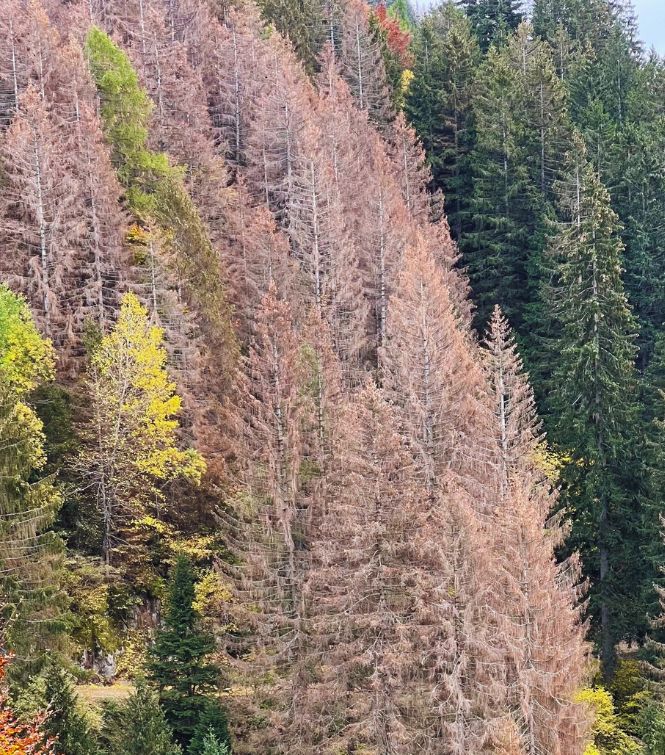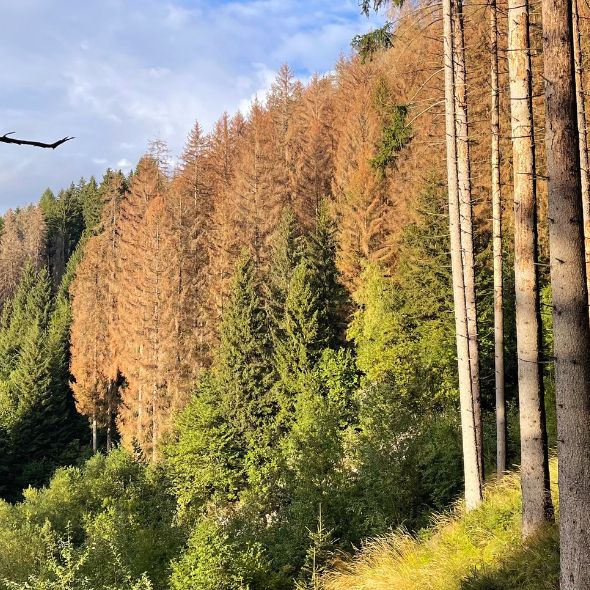The serious bark beetle epidemic is affecting and destroying the forests of the Dolomites. Together we can plant new trees to promote the biodiversity of the ecosystem and give our forests a future.

The bark beetle is a small, indigenous beetle that has always lived in our areas. It plays a useful role in nature: it mainly attacks spruce trees and can detect weak or diseased plants. Its intervention accelerates the decomposition process of fallen trees, thus helping to return nutrients to the soil and keep the forest ecosystem healthy.
In the past, there was only one bark beetle life cycle per spring and summer. However, after the devastating storm Vaia in 2018 and due to climate change, the situation has worsened. Longer and drier summers, even at altitudes above 1,500 metres, and too mild winters no longer allow the population of these insects to be contained. Up to 3-4 new populations per year can now be observed, a huge problem for our forests.
The bark beetle burrows under the bark and creates tunnels where it lays its eggs. The larvae continue to burrow to feed, cutting off nutrient flow and leading the plant to its death. With the thousands of trees felled by the weather, the bark beetle has found an ideal habitat, but the growing population has encouraged the insect to attack even healthy trees.
The result? Millions of plants destroyed, with serious damage to forests in north-eastern Italy and forests throughout Europe. In 2020, up to 200,000 were caught, when the emergency threshold set by the European Union is 8,000 insects per year.
Promoting the repopulation of the forest with the reforestation of new trees to ensure biodiversity is what VAIA is committed to doing to stem the proliferation of the bark beetle.
As Cristina Salvadori – expert entomologist at the Plant Protection Service of the Autonomous Province of Trento – reminds us, ‘against the bark beetle there is no single effective cure for ever, because the phenomenon is constantly changing. Research, in this sense, is essential to study its evolution and methods to combat it. The bark beetle has indelibly damaged our forests, which will not be the same as before in the next 50-100 years. At the same time, it has provided us with valuable information that will help us take the right measures for the future, the future of the forest to come’.
When we see large red patches on mountain slopes and damaged forests everywhere, it is natural to ask: “Why not cut down the affected trees immediately to stop the bark beetle spread in the forests and protect the healthy trees?” The answer, however, is not so simple. Diseased trees cannot always be removed immediately. Stumps must remain to stabilize slopes, even the roots of a dead tree can hold the soil for years. Every intervention must be done carefully, to maintain the balance of the mountain and protect it in the long term.
The forests of the Dolomites are often dominated by the presence of spruce, a species with shallow roots that is fragile in the face of extreme weather events. In the past, storms such as Vaia were rare, which is why the spread of spruce, prized for its valuable wood, was favoured. Today, however, a new approach is needed. Promoting biodiversity-oriented reforestation, with more resistant species such as larch or beech, can strengthen forests, protect the soil and reduce hydrogeological risks, while ensuring the safety of local communities.
Before planting a tree, the Forestry Authority makes sure that the ground is ready for it. This means cleaning up the area by removing weeds, fallen branches, dead trunks and anything else that might hinder the growth of the new plants to ensure they are in the best condition.
The work of foresters does not end with the planting of trees. To ensure that the forest grows healthy and strong over time, it is necessary to continue with various care and maintenance activities. During the first few years, trees need to be watered and maintained regularly, pests and diseases need to be monitored, and it is also important to control weeds, which could deplete vital resources such as water, sunlight and nutrients. Forestry experts constantly monitor the environmental conditions of the site to assess the impact of reforestation on the surrounding ecosystem and adapt management practices as needed.
A local artisanal supply chain that turns bark beetle-affected forests into a community project: VAIA People, the elegance of wood and much more!






